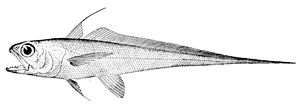Luminous hake facts for kids
Quick facts for kids Luminous hake |
|
|---|---|
 |
|
| Scientific classification | |
| Genus: |
Steindachneria
|
| Species: |
argentea
|
The luminous hake (Steindachneria argentea) is a special kind of fish that lives in the deep waters of the western Atlantic Ocean. It's the only fish in its group, which makes it quite unique! This fish belongs to the Merluccidae family, which includes other types of hake.
What Does It Look Like?
Luminous hake can grow up to about 30 centimeters (12 inches) long. They have a shiny silver body, with a bit of brown on their back and a purple tint on their belly. Their mouth area is dark.
This fish has big eyes and a large head. Its body gets narrower towards the back and ends in a point because it doesn't have a tail fin (also called a caudal fin). What makes them special is their ability to glow! They have a special glowing organ on the sides of their head and along the lower part of their body. This is called bioluminescence, which means they can make their own light.
The luminous hake has a straight line along its side called a lateral line. This line helps them sense movements and vibrations in the water. They have 18 to 20 gill rakers, which are small, comb-like structures that help them filter food from the water.
They have two dorsal fins (fins on their back). The first dorsal fin has one spine. They also have one anal fin (on their belly, near the tail) with 123 to 125 soft rays. They have paired pectoral fins (on their sides, like arms) with 14 to 17 soft rays, and pelvic fins (on their chest area) that also have soft rays.
Where Does It Live?
Luminous hake are often found in deep parts of the ocean. They live on the outer edges of the continental shelf and on soft, muddy seabeds in the Western Atlantic. You can find them from Florida and the northern Gulf of Mexico all the way through Central America to Venezuela. These fish usually live at depths of 400 to 500 meters (about 1,300 to 1,600 feet) below the surface.
Fun Facts
- People don't usually fish for luminous hake, so it's not important for the fishing industry.
- Another type of hake, called Merluccius albidus, sometimes hunts and eats the luminous hake.
See also
In Spanish: Mollera luminosa para niños

